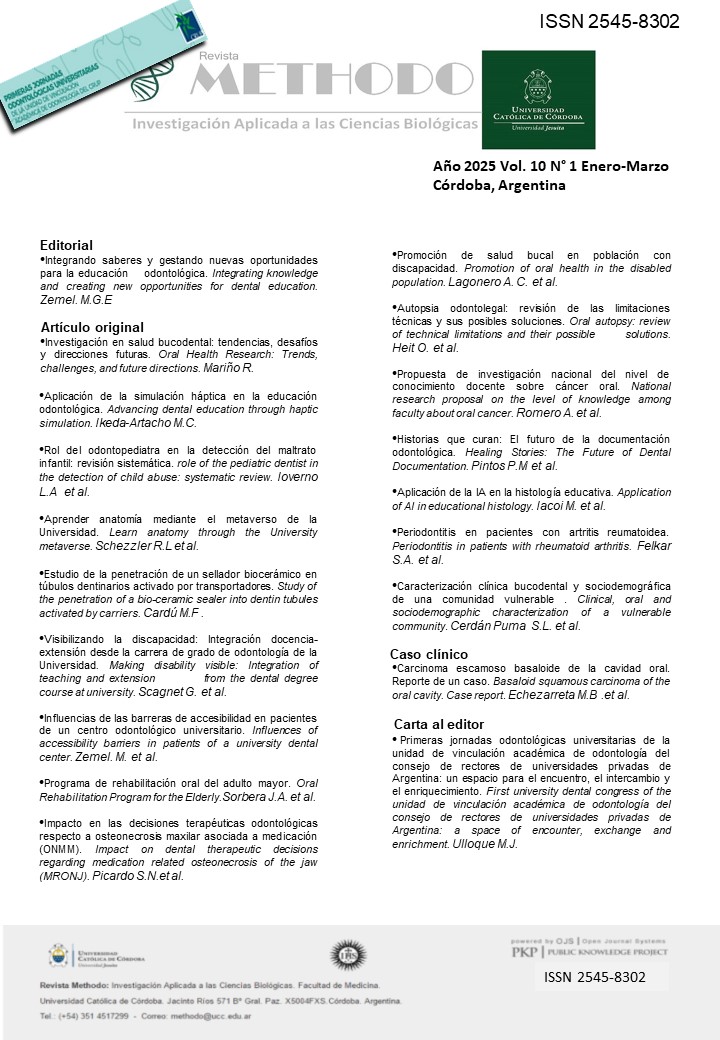Estudio de la penetración de un sellador biocerámico en túbulos dentinarios activado por transportadores
DOI:
https://doi.org/10.22529/me.2025.10(1)06Palabras clave:
Silicato de calcio, xp-endo finisher, penetración de canalículos dentinarios, obturación endodónticaResumen
La obturación de los conductos radiculares tiene como finalidad originar el sellado hermético del espacio en el que antes se hallaba el tejido pulpar, impidiendo de ese modo la migración de los microorganismos, asegurando la salud periapical. La eficacia de la obturación lograda se evalúa por la capacidad de ocupar las irregularidades en el conducto, la aparición de huecos entre los materiales y la penetración del túbulo dentinario. Esta última genera un cierre físico-mecánico, aumentando así la retención, mejorando el sellado y entorpeciendo la microfiltración entre la masa del sellador y las paredes del conducto. El objetivo de este estudio es evaluar, mediante un microscopio láser confocal, la profundidad de penetración del túbulo dentinario de un sellador a base de silicato tricálcico después de dispensar el cemento con el instrumento XP-Endo Finisher y otros portadores, adicionando la obturación con un cono de gutapercha mediante la técnica de cono único.
Este proyecto de investigación fue aprobado por el Comitê de Ética em Pesquisa da Universidade Federal do Rio Grande do Sul (UFRGS). Se utilizaron cincuenta dientes bovinos, cortados mediante máquina metalográfica para estandarizar las muestras a 12mm de longitud, y cuyos conductos fueron preparados con un instrumento reciprocante calibre 50. Luego de la preparación, e inmediatamente al secado, se mezcló un sellador a base de silicato de calcio con colorante Fluo-3. Para la colocación del sellador, las raíces fueron distribuidas aleatoriamente en cinco grupos: Control, Léntulo, EndoActivator, Ultrasonido y XP-Endo Finisher (N=10). 7 días después de la obturación, el tercio apical de cada muestra se seccionó transversalmente en rodajas de 2 mm correspondientes a los tercios apicales a 2 y 4 mm del ápice.
Las muestras se evaluaron mediante microscopía láser confocal Olympus Fluoview 100 (Olympus Corporation, Tokio, Japón) con excitación de luz de longitud de onda de 559 nm. Las imágenes se registraron en modo fluorescente, aumento de 10x y una apertura numérica de 0,3 y 1,3 mm respectivamente. El área de penetración del sellador dentro del túbulo dentinario fue generada por las imágenes obtenidas en el programa FluoView 10-ASW 4.2 (Olympus Corporation, Tokio, Japón). Cada imagen será importada al programa Adobe Photoshop CC2018 y luego la herramienta Lazo delimitará y medirá el área de penetración del sellador.
Publicado
Cómo citar
Número
Sección
Licencia
Derechos de autor 2024 Methodo Investigación Aplicada a las Ciencias Biológicas

Esta obra está bajo una licencia internacional Creative Commons Atribución-NoComercial-CompartirIgual 4.0.




















